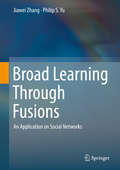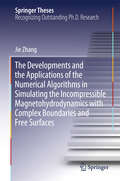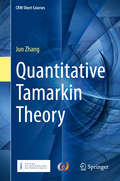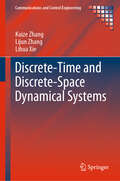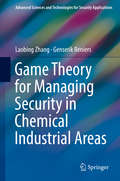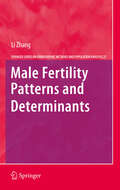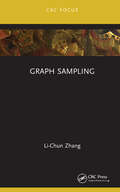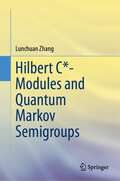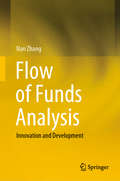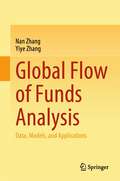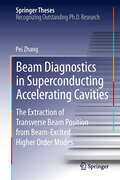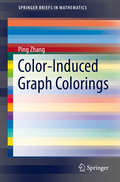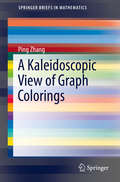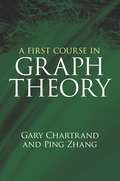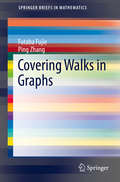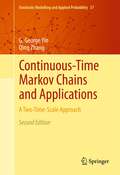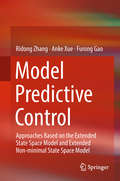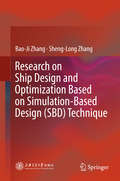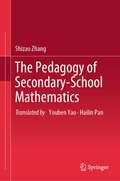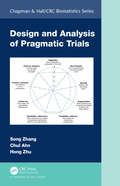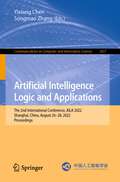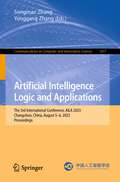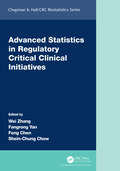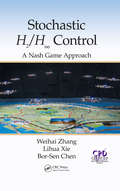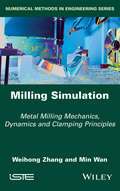- Table View
- List View
Broad Learning Through Fusions: An Application on Social Networks
by Jiawei Zhang Philip S. YuThis book offers a clear and comprehensive introduction to broad learning, one of the novel learning problems studied in data mining and machine learning. Broad learning aims at fusing multiple large-scale information sources of diverse varieties together, and carrying out synergistic data mining tasks across these fused sources in one unified analytic. This book takes online social networks as an application example to introduce the latest alignment and knowledge discovery algorithms. Besides the overview of broad learning, machine learning and social network basics, specific topics covered in this book include network alignment, link prediction, community detection, information diffusion, viral marketing, and network embedding.
The Developments and the Applications of the Numerical Algorithms in Simulating the Incompressible Magnetohydrodynamics with Complex Boundaries and Free Surfaces (Springer Theses)
by Jie ZhangThis thesis presents an accurate and advanced numerical methodology to remedy difficulties such as direct numerical simulation of magnetohydrodynamic (MHD) flow in computational fluid dynamics (CFD), grid generation processes in tokamak fusion facilities, and the coupling between the surface tension force and Lorentz force in the metallurgical industry. In addition, on the basis of the numerical platform it establishes, it also investigates selected interesting topics, e.g. single bubble motion under the influence of either vertical or horizontal magnetic fields. Furthermore, it confirms the relation between the bubble’s path instability and wake instability, and observes the anisotropic (isotropic) effect of the vertical (horizontal) magnetic field on the vortex structures, which determines the dynamic behavior of the rising bubble. The direct numerical simulation of magnetohydrodynamic (MHD) flows has proven difficult in the field of computational fluid dynamic (CFD) research, because it not only concerns the coupling of the equations governing the electromagnetic field and the fluid motion, but also calls for suitable numerical methods for computing the electromagnetic field. In tokamak fusion facilities, where the MHD effect is significant and the flow domain is complex, the process of grid generation requires considerable time and effort. Moreover, in the metallurgical industry, where multiphase MHD flows are usually encountered, the coupling between the surface tension force and Lorentz force adds to the difficulty of deriving direct numerical simulations.
Quantitative Tamarkin Theory (CRM Short Courses)
by Jun ZhangThis textbook offers readers a self-contained introduction to quantitative Tamarkin category theory. Functioning as a viable alternative to the standard algebraic analysis method, the categorical approach explored in this book makes microlocal sheaf theory accessible to a wide audience of readers interested in symplectic geometry. Much of this material has, until now, been scattered throughout the existing literature; this text finally collects that information into one convenient volume. After providing an overview of symplectic geometry, ranging from its background to modern developments, the author reviews the preliminaries with precision. This refresher ensures readers are prepared for the thorough exploration of the Tamarkin category that follows. A variety of applications appear throughout, such as sheaf quantization, sheaf interleaving distance, and sheaf barcodes from projectors. An appendix offers additional perspectives by highlighting further useful topics. Quantitative Tamarkin Theory is ideal for graduate students interested in symplectic geometry who seek an accessible alternative to the algebraic analysis method. A background in algebra and differential geometry is recommended.This book is part of the "Virtual Series on Symplectic Geometry"http://www.springer.com/series/16019
Discrete-Time and Discrete-Space Dynamical Systems (Communications and Control Engineering)
by Kuize Zhang Lijun Zhang Lihua XieDiscrete-Time and Discrete-Space Dynamical Systems provides a systematic characterization of the similarities and differences of several types of discrete-time and discrete-space dynamical systems, including:Boolean control networks;nondeterministic finite-transition systems;finite automata;labelled Petri nets; andcellular automata.The book's perspective is primarily based on topological properties though it also employs semitensor-product and graph-theoretic methods where appropriate. It presents a series of fundamental results: invertibility, observability, detectability, reversiblity, etc., with applications to systems biology.Academic researchers with backgrounds in applied mathematics, engineering or computer science and practising engineers working with discrete-time and discrete-space systems will find this book a helpful source of new understanding for this increasingly important class of systems. The basic results to be found within are of fundamental importance for further study of related problems such as automated synthesis and safety control in cyber-physical systems using formal methods.
Game Theory for Managing Security in Chemical Industrial Areas (Advanced Sciences and Technologies for Security Applications)
by Laobing Zhang Genserik ReniersThis book systematically studies how game theory can be used to improve security in chemical industrial areas, capturing the intelligent interactions between security managers and potential adversaries. The recent unfortunate terrorist attacks on critical infrastructures show that adversaries are intelligent and strategic. Game theoretic models have been extensively used in some domains to model these strategic adversaries. However, there is a lack of such advanced models to be employed by chemical security managers. In this book, game theoretic models for protecting chemical plants as well as clusters are proposed. Different equilibrium concepts are explored, with user-friendly explanation of how to reflect them to realistic cases. Based on efficient analysis of the properties of security issues in chemical plants/clusters, models in this book are capable to support resources allocations, cost-effectiveness analysis, cooperation incentives and alike.
Male Fertility Patterns and Determinants
by Li ZhangThis book discusses the biological, methodological and sociological issues that have caused men to be overlooked in demographic and sociological literature of fertility. It explores the patterns and determinants of male fertility and studies male fertility rates as compared to those of females in 43 countries and places, over time. Data used in the aggregate level analysis come from multiple sources, including the 2001 United Nations Demographic Yearbook, the 1964 to 2004 Taiwan-Fukien Demographic Yearbooks, and National Statistics Reports by the Statistics Bureau of Republic of China. To explore male fertility determinants, the book analyzes individual data from the 2002 National Survey of Family Growth (NSFG) in the United States. The findings presented here demonstrate that male fertility differs from female fertility in both rates and determinants, which suggests that female fertility cannot fully represent human fertility.
Graph Sampling
by Li-Chun ZhangMany technological, socio-economic, environmental, biomedical phenomena exhibit an underlying graph structure. Valued graph allows one to incorporate the connections or links among the population units in addition. The links may provide effectively access to the part of population that is the primary target, which is the case for many unconventional sampling methods, such as indirect, network, line-intercept or adaptive cluster sampling. Or, one may be interested in the structure of the connections, in terms of the corresponding graph properties or parameters, such as when various breadth- or depth-first non-exhaustive search algorithms are applied to obtain compressed views of large often dynamic graphs. Graph sampling provides a statistical approach to study real graphs from either of these perspectives. It is based on exploring the variation over all possible sample graphs (or subgraphs) which can be taken from the given population graph, by means of the relevant known sampling probabilities. The resulting design-based inference is valid whatever the unknown properties of the given real graphs. One-of-a-kind treatise of multidisciplinary topics relevant to statistics, mathematics and data science. Probabilistic treatment of breadth-first and depth-first non-exhaustive search algorithms in graphs. Presenting cutting-edge theory and methods based on latest research. Pathfinding for future research on sampling from real graphs. Graph Sampling can primarily be used as a resource for researchers working with sampling or graph problems, and as the basis of an advanced course for post-graduate students in statistics, mathematics and data science.
Hilbert C*- Modules and Quantum Markov Semigroups
by Lunchuan ZhangThis book explains the basic theory of Hilbert C*-module in detail, covering a wide range of applications from generalized index to module framework. At the center of the book, the Beurling-Deny criterion is characterized between operator valued Dirichlet forms and quantum Markov semigroups, hence opening a new field of quantum probability research. The general scope of the book includes: basic theory of Hilbert C*-modules; generalized indices and module frames; operator valued Dirichlet forms; and quantum Markov semigroups.This book will be of value to scholars and graduate students in the fields of operator algebra, quantum probability and quantum information.
Flow of Funds Analysis: Innovation and Development
by Nan ZhangThis book discusses the theory, methods, and applications of flow of funds analysis. The book integrates the basic principles of economic statistics, financial accounts, international finance, econometric models, and financial network analysis, providing a systematic and comprehensive introduction to the interconnection between these research fields. It thus provides the reader with the intellectual groundwork indispensable for understanding the workings and interactions of today’s globalized financial markets. The main focus of the book is how to observe the flow of funds in macroeconomics, how to measure the global flow of funds (GFF), and how to use GFF data to carry out an analysis. Based on the statistical framework for measuring GFF under the System of National Accounts, the book identifies the systematic relationship of financial linkages among economic sectors and with the rest of the world while integrating data sources that include stock data, geographically broken down by country–region, and selected financial instruments. It sets out the GFF concept and constructs a GFF matrix (metadata) on a from-whom-to-whom basis within a country-by-country pattern. Lastly, an established GFF matrix table is used to conduct an empirical study including an econometric model and financial network analysis.
Global Flow of Funds Analysis: Data, Models, and Applications
by Nan Zhang Yiye ZhangThis book is the first to focus on the global flow of funds (GFF), providing an introduction to its fundamental concepts and establishing a theoretical framework for analysis. It connects the flow of funds within domestic economies to that of the rest of the world, offering a comprehensive analysis of GFF dynamics. This study enhances GFF statistics, enabling the assessment of global financial stability from both national and cross-border sectoral perspectives. The GFF data provide valuable insights into analyzing interconnectivity across borders and an understanding of global financial interdependencies. By examining the data sources and reconstructing the statistical framework to establish the GFF statistical matrix, this book conducts a case study to evaluate financial risks and influences in G20 countries. Subsequently, it connects the GFF matrix with sectoral account data and the flow of funds to establish the sectoral from-whom-to-whom financial stock matrix (SFSM). The SFSM aims to establish a new framework for conducting multi-country, multi-sector analysis within the G20, with a special emphasis on examining the national and cross-border exposures of sectors in China, Japan, and the USA. This involves constructing country-specific financial networks and connecting them based on cross-border exposures. The systematic analysis results effectively showcase the financial interconnections among G20 countries within the GFF and shed light on the attributes of external shocks and internal influences. The focus is particularly on the changes in risk exposure between China and the USA concerning their external assets and liabilities and the implications of economic decoupling of these dynamics.
Beam Diagnostics in Superconducting Accelerating Cavities: The Extraction of Transverse Beam Position from Beam-Excited Higher Order Modes (Springer Theses)
by Pei ZhangAn energetic charged particle beam introduced to an rf cavity excites a wakefield therein. This wakefield can be decomposed into a series of higher order modes and multipoles, which for sufficiently small beam offsets are dominated by the dipole component. This work focuses on using these dipole modes to detect the beam position in third harmonic superconducting S-band cavities for light source applications. A rigorous examination of several means of analysing the beam position based on signals radiated to higher order modes ports is presented. Experimental results indicate a position resolution, based on this technique, of 20 microns over a complete module of 4 cavities. Methods are also indicated for improving the resolution and for applying this method to other cavity configurations. This work is distinguished by its clarity and potential for application to several other international facilities. The material is presented in a didactic style and is recommended both for students new to the field, and for scientists well-versed in the field of rf diagnostics.
Color-Induced Graph Colorings: Vertex And Neighbor Distinguishing Edge Colorings Of Graphs (SpringerBriefs in Mathematics)
by Ping ZhangA comprehensive treatment of color-induced graph colorings is presented in this book, emphasizing vertex colorings induced by edge colorings. The coloring concepts described in this book depend not only on the property required of the initial edge coloring and the kind of objects serving as colors, but also on the property demanded of the vertex coloring produced. For each edge coloring introduced, background for the concept is provided, followed by a presentation of results and open questions dealing with this topic. While the edge colorings discussed can be either proper or unrestricted, the resulting vertex colorings are either proper colorings or rainbow colorings. This gives rise to a discussion of irregular colorings, strong colorings, modular colorings, edge-graceful colorings, twin edge colorings and binomial colorings. Since many of the concepts described in this book are relatively recent, the audience for this book is primarily mathematicians interested in learning some new areas of graph colorings as well as researchers and graduate students in the mathematics community, especially the graph theory community.
A Kaleidoscopic View of Graph Colorings (SpringerBriefs in Mathematics)
by Ping ZhangThis book describes kaleidoscopic topics that have developedin the area of graph colorings. Unifying current material on graph coloring,this book describes current information on vertex and edge colorings in graphtheory, including harmonious colorings, majestic colorings, kaleidoscopiccolorings and binomial colorings. Recently there have been a number of breakthroughs in vertex coloringsthat give rise to other colorings in a graph, such as graceful labelings ofgraphs that have been reconsidered under the language of colorings. The topics presented in this book include sample detailedproofs and illustrations, which depicts elements that are often overlooked. This book is ideal for graduate students and researchers in graph theory, as itcovers a broad range of topics and makes connections between recentdevelopments and well-known areas in graph theory.
A First Course in Graph Theory
by Ping Zhang Gary ChartrandWritten by two of the most prominent figures in the field of graph theory, this comprehensive text provides a remarkably student-friendly approach. Geared toward undergraduates taking a first course in graph theory, its sound yet accessible treatment emphasizes the history of graph theory and offers unique examples and lucid proofs. 2004 edition.
Covering Walks in Graphs (SpringerBriefs in Mathematics)
by Ping Zhang Futaba FujieCovering Walks in Graphs is aimed at researchers and graduate students in the graph theory community and provides a comprehensive treatment on measures of two well studied graphical properties, namely Hamiltonicity and traversability in graphs. This text looks into the famous Kӧnigsberg Bridge Problem, the Chinese Postman Problem, the Icosian Game and the Traveling Salesman Problem as well as well-known mathematicians who were involved in these problems. The concepts of different spanning walks with examples and present classical results on Hamiltonian numbers and upper Hamiltonian numbers of graphs are described; in some cases, the authors provide proofs of these results to illustrate the beauty and complexity of this area of research. Two new concepts of traceable numbers of graphs and traceable numbers of vertices of a graph which were inspired by and closely related to Hamiltonian numbers are introduced. Results are illustrated on these two concepts and the relationship between traceable concepts and Hamiltonian concepts are examined. Describes several variations of traceable numbers, which provide new frame works for several well-known Hamiltonian concepts and produce interesting new results.
Continuous-Time Markov Chains and Applications: A Two-Time-Scale Approach (Stochastic Modelling and Applied Probability #37)
by Qing Zhang G. George YinThis book gives a systematic treatment of singularly perturbed systems that naturally arise in control and optimization, queueing networks, manufacturing systems, and financial engineering. It presents results on asymptotic expansions of solutions of Komogorov forward and backward equations, properties of functional occupation measures, exponential upper bounds, and functional limit results for Markov chains with weak and strong interactions. To bridge the gap between theory and applications, a large portion of the book is devoted to applications in controlled dynamic systems, production planning, and numerical methods for controlled Markovian systems with large-scale and complex structures in the real-world problems. This second edition has been updated throughout and includes two new chapters on asymptotic expansions of solutions for backward equations and hybrid LQG problems. The chapters on analytic and probabilistic properties of two-time-scale Markov chains have been almost completely rewritten and the notation has been streamlined and simplified. This book is written for applied mathematicians, engineers, operations researchers, and applied scientists. Selected material from the book can also be used for a one semester advanced graduate-level course in applied probability and stochastic processes.
Model Predictive Control: Approaches Based On The Extended State Space Model And Extended Non-minimal State Space Model
by Ridong Zhang Anke Xue Furong GaoThis monograph introduces the authors’ work on model predictive control system design using extended state space and extended non-minimal state space approaches. It systematically describes model predictive control design for chemical processes, including the basic control algorithms, the extension to predictive functional control, constrained control, closed-loop system analysis, model predictive control optimization-based PID control, genetic algorithm optimization-based model predictive control, and industrial applications. Providing important insights, useful methods and practical algorithms that can be used in chemical process control and optimization, it offers a valuable resource for researchers, scientists and engineers in the field of process system engineering and control engineering.
Research on Ship Design and Optimization Based on Simulation-Based Design (SBD) Technique
by Sheng-Long Zhang Bao-Ji ZhangShip optimization design is critical to the preliminary design of a ship. With the rapid development of computer technology, the simulation-based design (SBD) technique has been introduced into the field of ship design. Typical SBD consists of three parts: geometric reconstruction; CFD numerical simulation; and optimization. In the context of ship design, these are used to alter the shape of the ship, evaluate the objective function and to assess the hull form space respectively. As such, the SBD technique opens up new opportunities and paves the way for a new method for optimal ship design. This book discusses the problem of optimizing ship’s hulls, highlighting the key technologies of ship optimization design and presenting a series of hull-form optimization platforms. It includes several improved approaches and novel ideas with significant potential in this field
The Pedagogy of Secondary-School Mathematics
by Shizao ZhangThis book elucidates the principal aspects and characteristics of secondary school mathematics teaching and learning in China. It combines the cultivation of students' mathematical abilities with the improvement of teaching skills, and explores from both theory and practice to create mathematical pedagogy which has been widely recognized by experts in this field. This book presents a number of mathematics teaching principles and methods, and has been used as an important resource book for mathematics teachers’ education.
Design and Analysis of Pragmatic Trials (Chapman & Hall/CRC Biostatistics Series)
by Song Zhang Chul Ahn Hong ZhuThis book begins with an introduction of pragmatic cluster randomized trials (PCTs) and reviews various pragmatic issues that need to be addressed by statisticians at the design stage. It discusses the advantages and disadvantages of each type of PCT, and provides sample size formulas, sensitivity analyses, and examples for sample size calculation. The generalized estimating equation (GEE) method will be employed to derive sample size formulas for various types of outcomes from the exponential family, including continuous, binary, and count variables. Experimental designs that have been frequently employed in PCTs will be discussed, including cluster randomized designs, matched-pair cluster randomized design, stratified cluster randomized design, stepped-wedge cluster randomized design, longitudinal cluster randomized design, and crossover cluster randomized design. It demonstrates that the GEE approach is flexible to accommodate pragmatic issues such as hierarchical correlation structures, different missing data patterns, randomly varying cluster sizes, etc. It has been reported that the GEE approach leads to under-estimated variance with limited numbers of clusters. The remedy for this limitation is investigated for the design of PCTs. This book can assist practitioners in the design of PCTs by providing a description of the advantages and disadvantages of various PCTs and sample size formulas that address various pragmatic issues, facilitating the proper implementation of PCTs to improve health care. It can also serve as a textbook for biostatistics students at the graduate level to enhance their knowledge or skill in clinical trial design. Key Features: Discuss the advantages and disadvantages of each type of PCTs, and provide sample size formulas, sensitivity analyses, and examples. Address an unmet need for guidance books on sample size calculations for PCTs; A wide variety of experimental designs adopted by PCTs are covered; The sample size solutions can be readily implemented due to the accommodation of common pragmatic issues encountered in real-world practice; Useful to both academic and industrial biostatisticians involved in clinical trial design; Can be used as a textbook for graduate students majoring in statistics and biostatistics.
Artificial Intelligence Logic and Applications: The 2nd International Conference, AILA 2022, Shanghai, China, August 26–28, 2022, Proceedings (Communications in Computer and Information Science #1657)
by Songmao Zhang Yixiang ChenThis book constitutes refereed proceedings of the 2nd International Conference on Artificial Intelligence Logic and Applications 2022 held in Shanghai, China from August 26–28, 2022.The 20 full papers presented in this volume were carefully reviewed and selected from a total of 27 submissions. The papers in the volume are organised according to the following topical headings: program logic; fuzzy logic; applications; author index.
Artificial Intelligence Logic and Applications: The 3rd International Conference, AILA 2023, Changchun, China, August 5–6, 2023, Proceedings (Communications in Computer and Information Science #1917)
by Songmao Zhang Yonggang ZhangThis book constitutes the proceedings of the Third International Conference, AILA 2023, held in Changchun, China, during August 5–6, 2023. The 26 full papers and the 10 short papers included in this volume were carefully reviewed and selected from 56 submissions. This volume aims to provide novel ideas, original research achievements, and practical experiences in a broad range of artificial intelligence logic and applications.
Advanced Statistics in Regulatory Critical Clinical Initiatives (Chapman & Hall/CRC Biostatistics Series)
by Wei ZhangAdvanced Statistics in Regulatory Critical Clinical Initiatives is focused on the critical clinical initiatives introduced by the 21st Century Cure Act passed by the United States Congress in December 2016. The book covers everything from the outline of the initiatives to analysis on the effect on biopharmaceutical research and development. Advanced Statistics in Regulatory Critical Clinical Initiatives provides innovative ways to resolve common challenges in statistical research of rare diseases such small sample sizes and provides guidance for combined use of data. With analysis from regulatory and scientific perspectives this book is an ideal companion for researchers in biostatistics, pharmaceutical development, and policy makers in related fields.Key Features: Provides better understanding of innovative design and analysis of each critical clinical initiatives which may be used in regulatory review/approval of drug development. Makes recommendations to evaluate submissions accurately and reliably. Proposes innovative study designs and statistical methods for oncology and/or rare disease drug development. Provides insight regarding current regulatory guidance on drug development such as gene therapy and rare diseases.
Stochastic H2/H ∞ Control: A Nash Game Approach
by Weihai Zhang Lihua Xie Bor-Sen ChenThe H∞ control has been one of the important robust control approaches since the 1980s. This book extends the area to nonlinear stochastic H2/H∞ control, and studies more complex and practically useful mixed H2/H∞ controller synthesis rather than the pure H∞ control. Different from the commonly used convex optimization method, this book applies the Nash game approach to give necessary and sufficient conditions for the existence and uniqueness of the mixed H2/H∞ control. Researchers will benefit from our detailed exposition of the stochastic mixed H2/H∞ control theory, while practitioners can apply our efficient algorithms to address their practical problems.
Milling Simulation: Metal Milling Mechanics, Dynamics and Clamping Principles
by Weihong Zhang Min WanReliable scheduling in cutting conditions is very important in machining processes, and this requires thorough understanding of the physical behaviors of the machining process, which cannot be achieved without understanding the underlying mechanism of the processes. The book describes the mechanics and dynamics together with the clamping principles in milling processes, and can be used as a guideline for graduate students and research engineers who wish to be effective manufacture engineers and researchers. Many books have focused on common principles, which are suitable for general machining processes, e.g., milling, turning and drilling, etc. This book specifically aims at exploring the mechanics and dynamics of milling processes. Original theoretical derivations and new observations on static cutting force models, dynamic stability models and clamping principles associated with milling processes are classified and detailed. The book is indented as a text for graduate students and machining engineers who wish to intensively learn milling mechanism and machine tool vibration.
